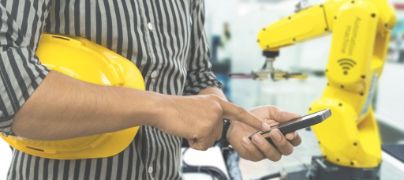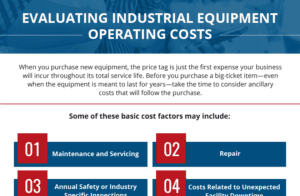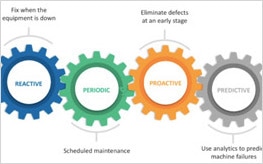When you purchase new equipment, the price tag is just the first expense your business will incur throughout its total service life. Before you purchase a big-ticket item—even when the equipment is meant to last for years—take the time to consider ancillary costs that will follow the purchase.
Some of these basic cost factors may include:
- Maintenance and Servicing
- Repairs
- Annual Safety or Industry-Specific Inspections
- Costs Related to Unexpected Facility Downtime
- Improvements and Upgrades
How to Calculate Equipment Operating Costs
Calculating the hard numbers behind operational costs and the costs of ownership can protect a business’s cash flow and profitability. Consider each of these specific areas of cost while evaluating the need for a specific piece of equipment.
Annual and Hourly Costs
The annual operational cost is made up of fixed costs and variable costs. The annual fixed costs include:
- Annual Depreciation
- Insurance
- Tax Costs
The annual variable costs include:
- Hourly Energy Consumption
- Consumables Lost During Use
- Maintenance Costs
- Repair Costs
If you multiply the variable costs—which are typically calculated by the hour—by annual hours of operation and add the expenditure to the annual fixed costs, you can calculate the total annual cost of owning the equipment.
Conversely, you can calculate the total hourly cost of operation by dividing the annual fixed costs by the number of annual operation hours and adding it to the variable hourly cost.
Changeovers
Another hidden cost of equipment ownership is changeovers. When equipment uses multiple different parts or attachments, consider the cost of production downtime when you’re switching to other functions. Automated systems such as customizable APPs and smart tools can reduce the time and associated costs.
Reliability
When machines break down, your facility can’t produce goods or maintain deliverable deadlines. Calculate the cost of repairs, replacement parts, and potential loss of business (or penalties for lateness) into the total cost of ownership. It may be more cost-effective to purchase more expensive but more reliable equipment than initially cheaper equipment with a higher risk of failure.
Electricity and Energy Costs
Your facility’s energy costs will vary based on the type of energy source, your location, and electricity peak demands. Analyze your facility’s past energy costs as a starting point for determining potential future costs.
Labor Costs
Generally speaking, equipment can’t run by itself. While manufacturing machinery and tools are increasingly smart and automated, most still require some degree of human oversight. Calculate the equipment’s associated human labor costs per hour, including the costs of:
- Supervisors
- Technicians
- Specialized Labor
- Inspectors
These costs don’t just include wages or salaries. Also, calculate the total cost of insurance, benefits, taxes, and the administrative costs of payroll for any operators into your total calculation.
How to Reduce Costs in Manufacturing
Fortunately, there are ways to offset these costs. Those measures include the following steps:
1. Monitor Unplanned Downtime
Unplanned downtime has the greatest potential for disrupting your business’s reputation and profits. Keep detailed records of each incident, including the cause, the solution, the duration, and the impacted customers. This information can help you respond faster and repair relationships with your customers.
2. Use Predictive Maintenance
Preventative maintenance is one of the best ways to reduce the risk of malfunctions and shutdowns. Improve the process by using predictive maintenance, active monitoring systems, and regular inspections to prevent downtime before it starts. A comprehensive maintenance plan will include all of these factors.
3. Increase Worker Training
Over-scheduling, poorly calibrated equipment, and other areas of waste can drive up costs. Train your employees on the best operational procedures. This can increase productivity per hour and reduce waste that increases operational costs.
Affordable Automation from Big Sky Manufacturing
Big Sky Manufacturing offers cost-effective automation solutions that meet the shifting needs of the packaging sector. We work with each client from development and sales through installation and startup to ensure that the equipment they purchase is well-suited to their unique application. We fabricate and program all of our own control systems and electrical panels using our fleet of in-house equipment and our in-house weld shop.
For more information about automation solutions from Big Sky Manufacturing, please contact us or request a quote.





